 After she homicides Johnny, she's going to homicide everyone else who ever crossed her too. 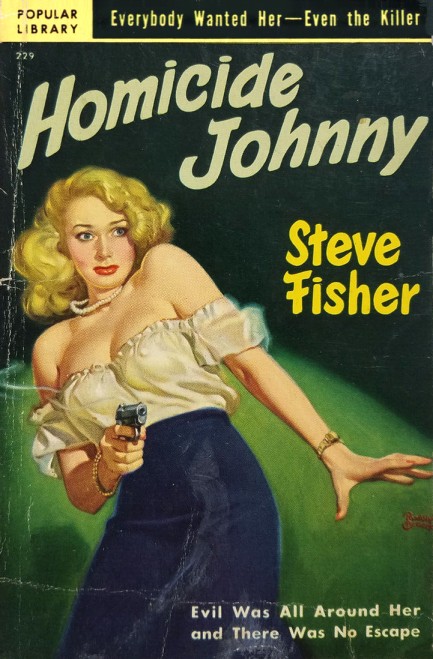
We've returned to Steve Fisher, as we said we would, after reading his 1954 social drama Giveaway. We chose Homicide Johnny because of the title and the Rudolph Belarski cover art. The tale stars Johnny West, a cop in tiny Mamaroneck, New York, about to give up his badge for a private detective gig in far away San Francisco, but who's pulled into one last case. A priceless anti-streptococcic compound has been stolen, and West not only has to solve the crime, but must work with his ex-girlfriend, police investigator Penny Lane. She has a very good if not photographic memory—which is too bad for Johnny because she can't forget or forgive that time he cheated on her. Collaborating with someone who seems to despise you isn't easy, but without trust and cooperation a murderer just might generate more victims. Spoiler alert: he does. Despite Steve Fisher's good rep, we consider Homicide Johnny to be average, even with its unusual medical research backdrop and relationship tension. But there was nothing in it to discourage us from trying him again, so expect to see him here down the line.
 No, seriously. I said come and get me. Don't just stand there. Or... did I interrupt something? 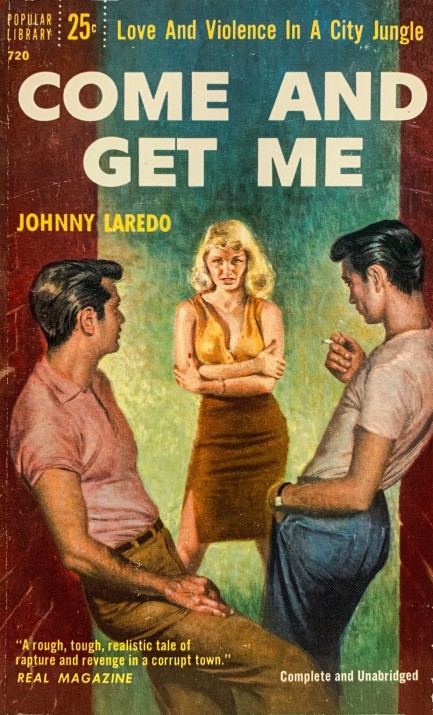
Above is a cover for Johnny Laredo's Come and Get Me, copyright 1956 from Popular Library. Think Laredo is a pseudonym? You think correctly. The publishers make a big deal out of keeping his real identity secret, writing a blurb inside the book calling Laredo, “the pseudonym of a young fiction writer whose stories have appeared in Argosy, The Virginia Quarterly Review, Cosmopolitan, and Bluebook.” Why an extensively published author wanted no credit for this book is a mystery, but the gig is up—he was Gene Caesar, a writer who had an affinity for westerns, but here crafted a crime drama about a man bent on avenging the murder of his girlfriend. The art, which we love because it can be interpreted a couple of ways, is by Raymond Johnson.
 Oh, good. Hard liquor. I hope you have more, because I'm gonna need lots before we continue. 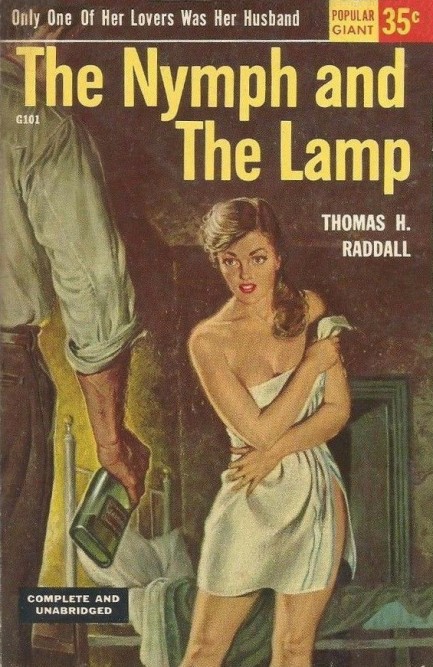
It's another case of a good-girl-art makeover, as this 1952 Popular Giant paperback edition of Thomas H. Raddall's 1950 novel The Nymph and the Lamp disguises as titillation what is actually a piece of serious literature by one of Canada's most renowned authors. The guy even has a park named after him—Thomas Raddall Provincial Park, located in Nova Scotia, where he lived much of his life. He also co-founded the Queens County Historical Society, which runs the Thomas Raddall Research Centre, where visitors can see an exact replica of his study, furnished with his actual possessions. And there's even the Thomas Head Raddall Award, which is given yearly to a writer from Canada's Atlantic provinces who produces the best work of adult fiction.
But we didn't know any of that when we read The Nymph and the Lamp, so we merely noted that it was an expertly written and deep reaching book about a grizzled telegraph operator named Matthew Carney who brings a somewhat younger woman named Isabel Jardin with him back to the lonely North Atlantic island outpost of Marina where he works with a small crew of colleagues, and lives together with them in the ancient telegraph building. Isabel didn't realize she was signing up for cohabitation with multiple men in a sort of industrial workplace, and naturally has adjustment issues:
The place reeked of hot oil. It had a concrete floor and in the midst of it a large single-cylinder gasoline engine whirled a pair of flywheels. From one of these a long slatting belt led her eye to the generator, spinning and whining at the farther end of the room. [snip] Isabel, standing on the greasy floor, was startled by a terrific sound as sharp, as deafening as rifle shots, and the little engine room was lit by a rapid succession of bright violet flashes that sprang, like the sound, from the revolving brass spark-studs at the end of the generator shaft. Casting dignity aside she fled into the hall and covered her ears with her hands.
Matthew merely grinned. “You’ll get used to it,” he declared calmly. “There’s a muffling drum that fits over the spark disc but we leave it off.”
“Do you mean to say,” she demanded in a voice that sounded thin and strange in her singing ears, “that it goes on like that, day and night?”
“Only when the chap on watch is transmitting.”
“But the transmitting goes on day and night—at intervals, I mean?”
“Oh yes. As I say, you’ll get used to it.”
The island has other inhabitants aside from Isabel and the telegraphers. There's a cadre of lifesavers who patrol the beaches for survivors of the frequent wrecks, a permanent lighthouse crew, and all the various workers' wives and children. There are also wild ponies living among the windswept dunes, and plenty of seals and oceangoing birds. None of it thrills or interests Isabel, but she's legitimately committed to Carney. The question is whether that committment can survive all the obstacles of life on a wild frontier.
Returning to the cover art, the creator here is Rafael DeSoto, who doesn't really get across the mood of the story. The rear cover text, which is written in such a way as to compliment the painting, is also misleading. Someone does barge in on Isabel, but it's an accident, and he has zero designs on her. He's so drunk he doesn't realize he's in the wrong room. He's soon removed, and the incident has no further bearing on the tale. But we'll say this for GGA art—it has lured us into reading not just pulp style fiction, but obscure literary fiction too. Some of it, like The Nymph and the Lamp, is very good.
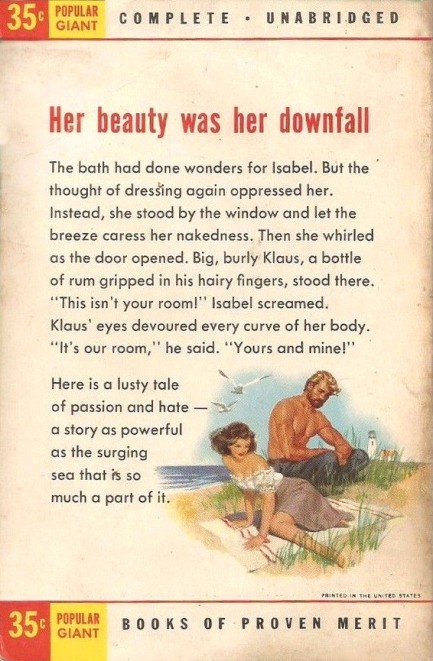
 I have something very serious to ask you. I'm ready. And our relationship is ready. Darling... will you lend me your car? 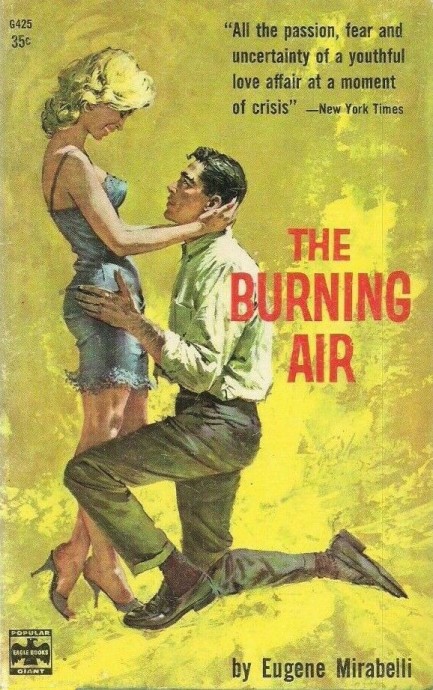
Above: Robert McGinnis cover art for Eugene Mirabelli's 1959 novel The Burning Air, with this Eagle Books edition coming in 1960. It's basically a drama about a young couple with some tricky relationship issues to work out. Like how he's going to get home when she leaves him there.
 No, my husband doesn't mind that I have sex with other men. Though he probably would if he knew. 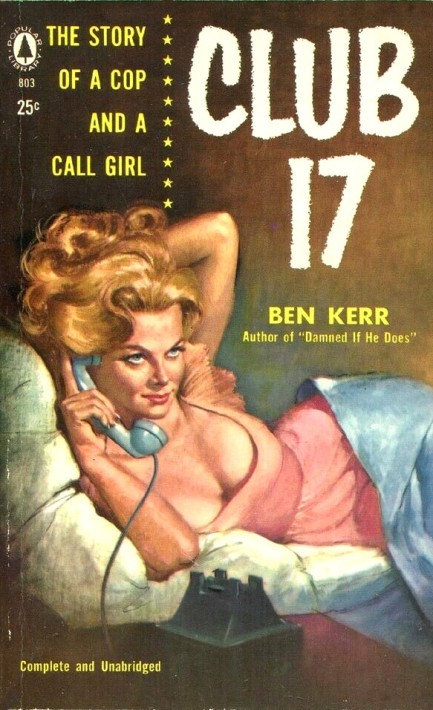
Ben Kerr, who we first knew as Mike Moran, then William Ard, might make the trusted author category. His 1957 novel Club 17 is a nice little yarn. It deals with a down-on-her-luck actress finally driven to prostitution, but her first customer is a vice cop out to bust the crime ring she works for, which operates out of an unassuming Manhattan watering hole called Club 17. She can't go through with the deed, which transforms the cop's appraisal of her from hooker to sweetheart, and romance is born.
We know what you're thinking, but the same old motif of love at first sight works because Kerr writes fast and with style. He had to write fast—he churned out three books a year, but his work didn't suffer for it. Some writers just have that gift. He pulls together a cohort of major characters—the cop, the call girl, the groomer, the pimp, a political climber, his two-timing wife, and a private investigator—and effortlessly sets the narrative spinning within only twenty pages.
Turning to the cover, which is amazing, it's unattributed, but we think it's by Ray Johnson. He was working with Popular Library from at least 1955 onward, as we've shown you here and here. The rear cover below reinforces our conviction on this. Look below and note the hair, the shape of the face, and that certain lift of the eyebrows, then check the links. He's the prime suspect. If so, excellent work, from a top rank illustrator.
 You know, instead of sitting around watching the clock we can try being naked in the day. Just once. Could be fun. 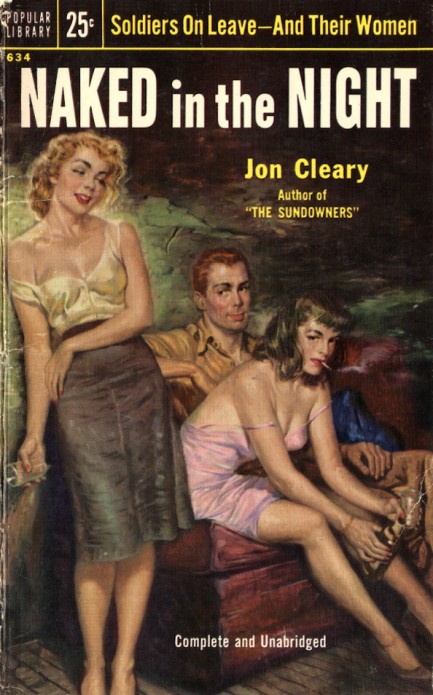
Puerto Rican illustrator Rafael DeSoto's cover work is always recognizable, not only because he often painted rosy-cheeked women on glowing backgrounds, but because his characters often had knowing or sly looks on their faces. On this piece for Jon Cleary's 1955 war drama Naked in the Night, you see the standing woman and sitting man sending sneaky nonverbal signals to each other and get the feeling that, come naked time, the brooding brunette won't get to join in the fun. That's classic DeSoto. He was a singular artist. See a few more secretly amused expressions here, here, and here.
 But it's just a bunch of white splatters. Is this all you managed to paint the two weeks I posed nude for you? 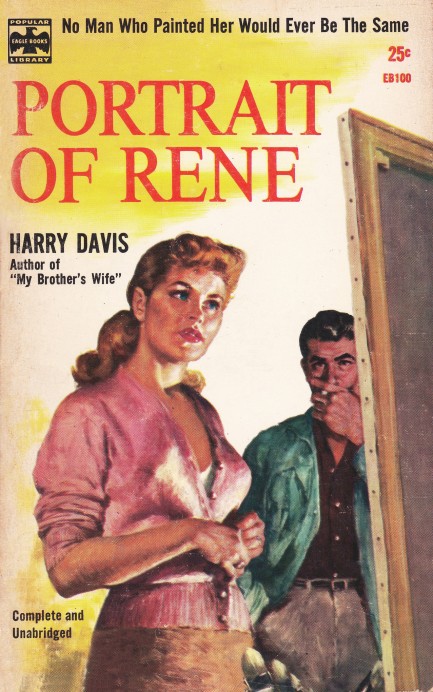
Our subhead is crude, but where else do you go with a cover like this? Cue the Pulp Intl. girlfriends: “White splatters? Not that far.” Maybe not, but hell, making up this stuff isn't easy. Speaking of which, Harry Davis's 1957 novel Portrait of Rene is about an artist named Lex Chaney who's not having an easy time. But his luck appears to change when he sells a portrait—the titular portrait of Rene—and the rich buyer, whose name is Ilse, hires him to administer art therapy to her invalid brother Paul. She lets Lex move into a property she owns where other friends and acquaintances of hers hang about as well. Lex finds himself in an environment of permissive behavior, and also of foreboding secrets having to do with inheritance, family history, and murder. Add in a layer infatuation and marital jealousy and you have yourself a recipe for trouble. We gravitated toward this particular book because we put together a collection of models and artists a while back and this fit right in. At least, we thought so, but the woman on the cover isn't a model—nude or otherwise—but the buyer Ilse. Close enough for us, though. See that collection here.
 Of course you're a man. What's surprising is you're the man in the park who bums smokes and plays pocket pool whenever I walk past. 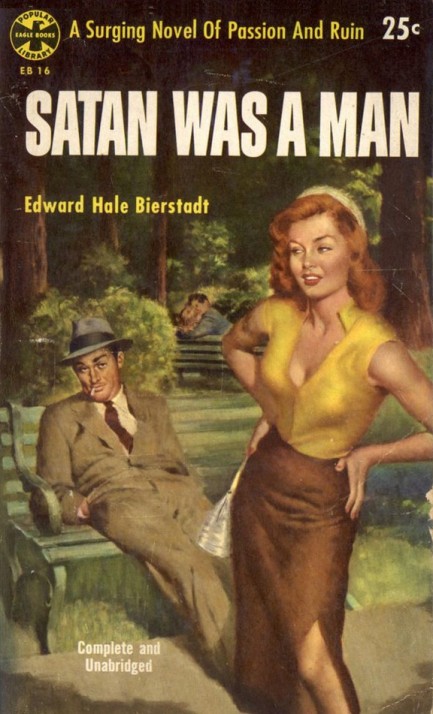
Satan takes many forms, as vintage literature makes clear—he's alternately a lesbian, a director, a guy named Stan, a goat-legged fellow, and even a presidential candidate. So, as this uncredited cover for Edward Hale Bierstadt's 1954 novel Satan Was a Man suggests, why not just a guy in the park? Even in such a mundane setting Satan could enjoy many small deceits and torments, like maybe ensuring that all the public restrooms are closed, or overfeeding pigeons so they'll crap on people. After all, posing as an investment banker or internet billionaire must get boring from time to time.
 Well, girls, Mai Tai number six did Becky in. Told you she didn't have what it takes to join a sorority. 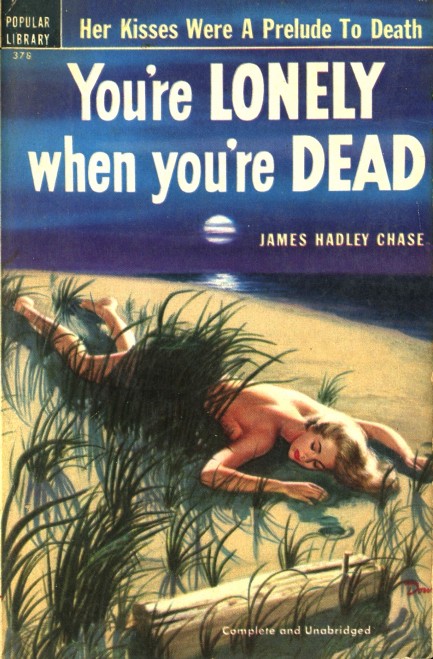
James Hadley Chase's 1939 debut novel was titled No Orchids for Miss Blandish. He later wrote a sequel with orchid in the title. And here in 1949's You're Lonely When You're Dead—for which you see a 1951 Popular Library edition with Willard Downes cover art—the action is centered around fictional Orchid City. So we guess he liked orchids. No drunk sorority girls in this one. The main character, Vic Malloy, who would star in other Orchid City capers, runs a fixer agency for rich folks, and is called in by a husband to look into the background of the woman he married after a whirlwind romance. Shady history turns up and bodies fall, starting with one of Malloy's operatives. Lonely when you're dead? Not in this book. The dead are a crowd, as characters go bye-bye in quick succession. Revenge, theft, blackmail, action, murder, and effective comic relief combine to make this a nice read. It's not quite Miss Blandish. But then how could it be?
 One esoteric murder method begets another. Possibly. 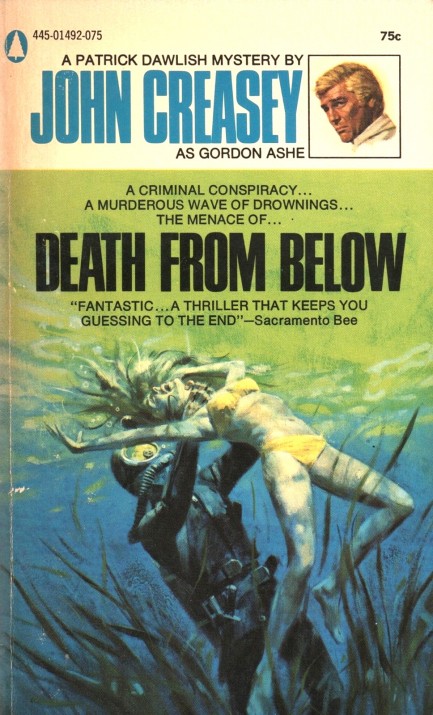
Concepts for thrillers can be hard to come by, so sometimes authors borrow from one another. Not long ago we read John D. MacDonald's The Drowner and shared the cover from the Gold Medal edition. Here you see British author John Creasey's, aka Gordon Ashe's, Death from Below. If you quickly click this link you'll notice the two books have identical art, thematically—a woman being pulled down into the water by an unidentified killer.
We figured Creasy borrowed from MacDonald, but interestingly, both books were originally published in 1963. Assuming months were spent actually writing them, it seems as if both authors simply had the same idea (we don't know if there was an earlier thriller with the same concept, but we wouldn't be surprised). The main difference between the tales is that MacDonald's killer drowns one person, where Creasy's goes full serial and drowns dozens, including children. His story also takes place in France, rather than the U.S., and has a deep—if unlikely—political element.
We know this scenario didn't happen, but we like to imagine both MacDonald and Creasy/Ashe walking into bookstores on opposite sides of the Atlantic sometime soon after both paperback editions had been released, seeing each other's on a shelf, and being mightily perturbed. At that point we like to imagine Creasy, in time-honored British fashion, saying, “MacDonald! That cheeky bugger!” MacDonald on the other hand, being American, probably went, “Creasy! That sneaky motherfucker!” Advantage: yanks.
 |  |
|
 |

The headlines that mattered yesteryear.
1933—The Gestapo Is Formed
The Geheime Staatspolizei, aka Gestapo, the official secret police force of Nazi Germany, is established. It begins under the administration of SS leader Heinrich Himmler in his position as Chief of German Police, but by 1939 is administered by the Reichssicherheitshauptamt, or Reich Main Security Office, and is a feared entity in every corner of Germany and beyond. 1937—Guernica Is Bombed
In Spain during the Spanish Civil War, the Basque town of Guernica is bombed by the German Luftwaffe, resulting in widespread destruction and casualties. The Basque government reports 1,654 people killed, while later research suggests far fewer deaths, but regardless, Guernica is viewed as an example of terror bombing and other countries learn that Nazi Germany is committed to that tactic. The bombing also becomes inspiration for Pablo Picasso, resulting in a protest painting that is not only his most famous work, but one the most important pieces of art ever produced. 1939—Batman Debuts
In Detective Comics #27, DC Comics publishes its second major superhero, Batman, who becomes one of the most popular comic book characters of all time, and then a popular camp television series starring Adam West, and lastly a multi-million dollar movie franchise starring Michael Keaton, then George Clooney, and finally Christian Bale. 1953—Crick and Watson Publish DNA Results
British scientists James D Watson and Francis Crick publish an article detailing their discovery of the existence and structure of deoxyribonucleic acid, or DNA, in Nature magazine. Their findings answer one of the oldest and most fundamental questions of biology, that of how living things reproduce themselves. 1967—First Space Program Casualty Occurs
Soviet cosmonaut Vladimir Komarov dies in Soyuz 1 when, during re-entry into Earth's atmosphere after more than ten successful orbits, the capsule's main parachute fails to deploy properly, and the backup chute becomes entangled in the first. The capsule's descent is slowed, but it still hits the ground at about 90 mph, at which point it bursts into flames. Komarov is the first human to die during a space mission.
|

|
|

It's easy. We have an uploader that makes it a snap. Use it to submit your art, text, header, and subhead. Your post can be funny, serious, or anything in between, as long as it's vintage pulp. You'll get a byline and experience the fleeting pride of free authorship. We'll edit your post for typos, but the rest is up to you. Click here to give us your best shot.

|
|




























































































